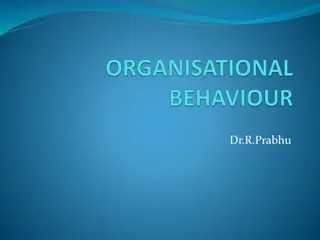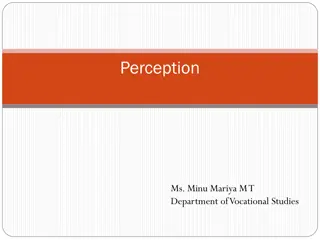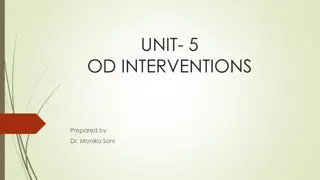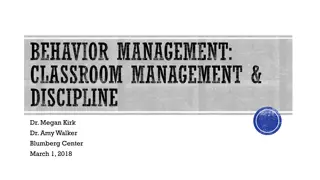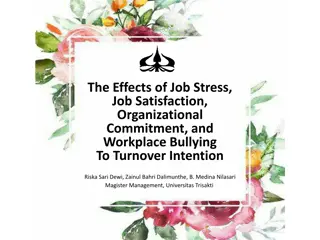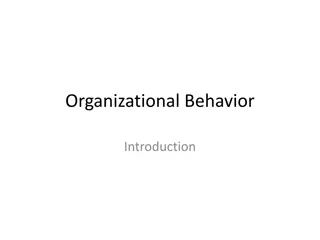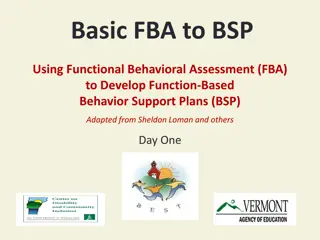Group Behavior and Dynamics in Organizational Settings
Exploring the foundations of group behavior in organizations, this content delves into formal and informal group structures, types of groups, and specific examples like task groups. It highlights how groups come together, interact, and work towards common objectives within organizational contexts.
Download Presentation

Please find below an Image/Link to download the presentation.
The content on the website is provided AS IS for your information and personal use only. It may not be sold, licensed, or shared on other websites without obtaining consent from the author.If you encounter any issues during the download, it is possible that the publisher has removed the file from their server.
You are allowed to download the files provided on this website for personal or commercial use, subject to the condition that they are used lawfully. All files are the property of their respective owners.
The content on the website is provided AS IS for your information and personal use only. It may not be sold, licensed, or shared on other websites without obtaining consent from the author.
E N D
Presentation Transcript
QUEENS COLLEGE OF ARTS AND SCIENCE FOR WOMEN PUNALKULAM,near Thanjavur, PUDUKKOTTAI DISTRICT. Dr. P. Sujatha, Ph.D SUBJECT: PRINCIPLES OF HOSPITALADMINISTRATION - II SUB CODE: 16SCCHA3 ASSISTANT PROFESSOR DEPARTMENT OF HOSPITALADMINISTRATION
FOUNDATIONS OF GROUP BUHAVIOUR Group: Two or more individuals, interacting and interdependent, who have come together to achieve particular objectives. . FORMAL GROUP INFORMAL GROUP A designated work group defined by an organisation s structure, with designated work assignments establishing tasks. Neither formally structured nor organizationally determined. Behaviours team members should engage in, are stipulated by and directed towards organizational goals. Natural formations in the work environment that appear in response to the need for social contact. Eg : The 6 members of an airline flight crew are a formal group. Eg : Three employees from different departments who regularly have lunch or coffee together are an informal group.
FOUNDATIONS OF GROUP BUHAVIOUR TYPES OF GROUPS
INFORMAL GROUP An informal group can be defined as one in which three or more people decide, perhaps on an ad hoc basis, to meet on a regular or semi-regular schedule for the purpose of discussing subjects of common interest, or for the purpose of engaging in a particular activity of common interest.
FORMAL GROUPS Formal groups are the ones that are created as per official authority, so as to fulfill the desired objective. Unlike, informal groups are formed by the employees as per their likes, interests, and attitudes.
Task group Task Group: A group of people working together to complete a job task. A task group can cross hierarchical command relationships. Eg: If a college student is accused of a campus crime, dealing with the problem might require coordination among the dean of academic affairs, the dean of students, the registrar, the director of security and the student s advisor. Such a formation constitutes a task group. All command groups are task groups. But all task groups are not command groups.
Command Group Command groups organizational chart and often consist of a supervisor and the subordinates that report to that supervisor. are specified by the An example of a command group is an academic department chairman and the faculty members in that department.
INTEREST GROUP Interest group is a group of individuals that share a common interest in a specific subject and work jointly to influence public policy in its favor. Interest groups pressure groups because they exert pressure on policy makers to influence public policies. are also called
FRIENDSHIP GROUPS. Friendship groups are formed by members who enjoy similar social activities, political beliefs, religious values, or other common bonds. ... For example, a group of employees who form a friendship group may have an exercise group, a softball team, or a potluck lunch once a month.
STAGES OF GROUP DEVELOPMENT
5 STAGES OF GROUP DEVELOPMENT Continue
Forming stage is a situation that members of a group dont truly understand about their duty, regulations and rules. The members cannot finish their job without leader or manager because they lack of confidence. They have to be encouraged and motivate them that it can help them to feel as a significant part of a team. Storming stage is a situation that it often starts when team members prefer to use conflicting work styles. People may work in different ways for all sorts of reasons, but if differing working styles cause unforeseen problems, they may become frustrated. Moving from this stage requires that the leader of team should strong ability to help all members accept each other and respect in each individual task. Continue
Norming stage is a period that team members know one- another better, they may socialize together, and they are able to ask each other for help and provide constructive feedback. At this point a group need to provide a delegate for making agreement and consensus. Performing stage is that all members can achieve the duty without any problems, but they want to develop the term in regard to interpersonal development. concentrate on developing performance of the team. A leader should Adjourning stage is the final task when especially a group is successful. The leader of the team must be appreciated with the achievement and show accomplishment is so proud. motivation to members to move on next thinks or another task. all This stage help increase member that their
Group structure Group structure is defined as the layout of a group. It is a combination of group roles, norms, conformity, workplace behavior, status, reference groups, status, social loafing, cohorts, group demography and cohesiveness. Group Roles The different roles a person plays as a part of the group. Underlying pattern of roles, norms and networks of relations among members that define and organize the group. CONTINUE
Groups are not unorganized, haphazard collections of individuals, but organized systems of interactions and relationships regulated by group structure Three important elements of group structure: Norms Roles and Networks of connections among the members continue
Norms Norms are implicit, self-generating, and stable standards for group behavior Prescriptive norms set the standards or expected group behavior Proscriptive norms identify behaviors that should not be performed Descriptive norms define what most people do, feel, or thing in the group. Injunctive norms differentiate between desirable and undesirable actions
Roles Roles specify the types of behaviors expected of individuals who occupy particular positions within the group. As members interact with one another, their role related activities become patterned (role differentiation) with Task roles pertaining to the work of the group, Relationship roles pertaining to maintaining relations among the members.
Status network Most groups develop a stable pattern of variations in authority and power (e.g. status networks, chains of command) through a status differential process. In some instances, people complete with one another for status in group; the resulting pecking order determines who is dominant and who is submissive. Group member s perception of one another also determine status. Berger s expectation-states theory argues that group members allocate status by considering specific status characteristics and diffuse status characteristics. Continue
When status generalization occurs, group members unfairly allow irrelevant characteristics such as: age, race, or ethnic background to influence the allocation of prestige. Status allocations are particularly unfair when individual who are members of stereotyped minority societal groups are also under represented in the group itself, with the most extreme case being solo status (being the only individual of that category in the group) In many online groups the effects of status on participation are muted, resulting in a participation equalization effect.
Communication networks A group s communication network may parallel formally established paths, but most groups also have informal network that defines who speaks to whom most frequently. Centralized networks are most efficient Shaw s concept of information saturation suggests not if tasks are too complex and require high levels of information exchange continue
A groups network, in addition to structuring communication, influences a variety in group and individual outcomes, including performance, effectiveness, and members level of satisfaction. Individuals who occupy more central positions in communication networks are often more influential than those located at the periphery. Since centralized networks have lower levels of closeness, the overall levels of member satisfaction in such groups tend to be lower.
Group Decision Making Group decision-making (also known as collaborative decision-making) situation faced collectively make a choice from the alternatives before them. The decision is then no longer attributable to any single individual who is a member of the group. is a when individuals
ADVANTAGES OF GROUP DECISION MAKING Compared to an individual, the groups generally have a greater knowledge, expertise, & skill base to make better decisions. Larger number of members provide more perspectives of the problem. With larger number of group members, the participation increases that helps reach quality decision. Following increased participation, comprehension of final decision arrived at is usually high.
Disadvantages of Group Decision- Making It is a time consuming process. Influencing members usually manipulate the group decision in a direction of their interest & liking. Sometimes decision made by the group members are simply a compromise between the various views & options offered by the group members..
CONSIDERATIONS IN GROUP DECISION MAKING Time Member competence AUTONOMY AND SELF-DIRECTION Availability of information Group size Degree of participation
Time Time is a vital factor in making the decisions sound. Logically, longer the time, better are the decision. But there is the problem of procrastination. Time factor is related to the method of approach. Where autocratic method is followed, time required is short, In contrast, it takes long time to decide if consensus approach is followed.
Member competence Decisions are sound when members are competent and possess knowledge and skill. In the consensus approach to decision-making, expected to be competent. In the autocratic model, it is only the leader who is said to be competent.. all members are
AUTONOMY AND SELF- DIRECTION Each method assumes that the member possess specific level of freedom and motivation. The consensus believes that all the members have the power and the autocratic approach fails to recognize such an assumption. In addition, autonomy and self-direction make-decisions sound. Where member involved in decision-making enjoy the freedom and the motivation, their decisions tend to be rational and effective approach motivation, but the
Availability of information The extent to which decision-making have the information determines soundness or otherwise of the decisions. Besides, each approach to decision-making assumes a certain degree of availability of information. Information available is the least in the autocratic approach but the consensus approach assumes that vast data are available to facilitate decision-making. before them,
Group size Larger the size of the group more will be delay in arriving at a decision. The process is fast when there is one leader or limited number of managers, decision-making. Consensus assumes that the number of members is large and hence delay in decision-making. Such a hassle does not exist in autocratic approach as only one leader makes decisions. responsible for approach
Degree of participation Business decisions need participation by several group members. Rarely are they made by one individual. Effective decision- making depends on whether managers involve the right people in the right ways in helping them solve problems. One model that provides guidance for practicing managers is developed by Victor Vroom and Arthur Jago . suffice it is to state that the mangers can use the model in deciding whether and in what capacity to involve others in making a decision














